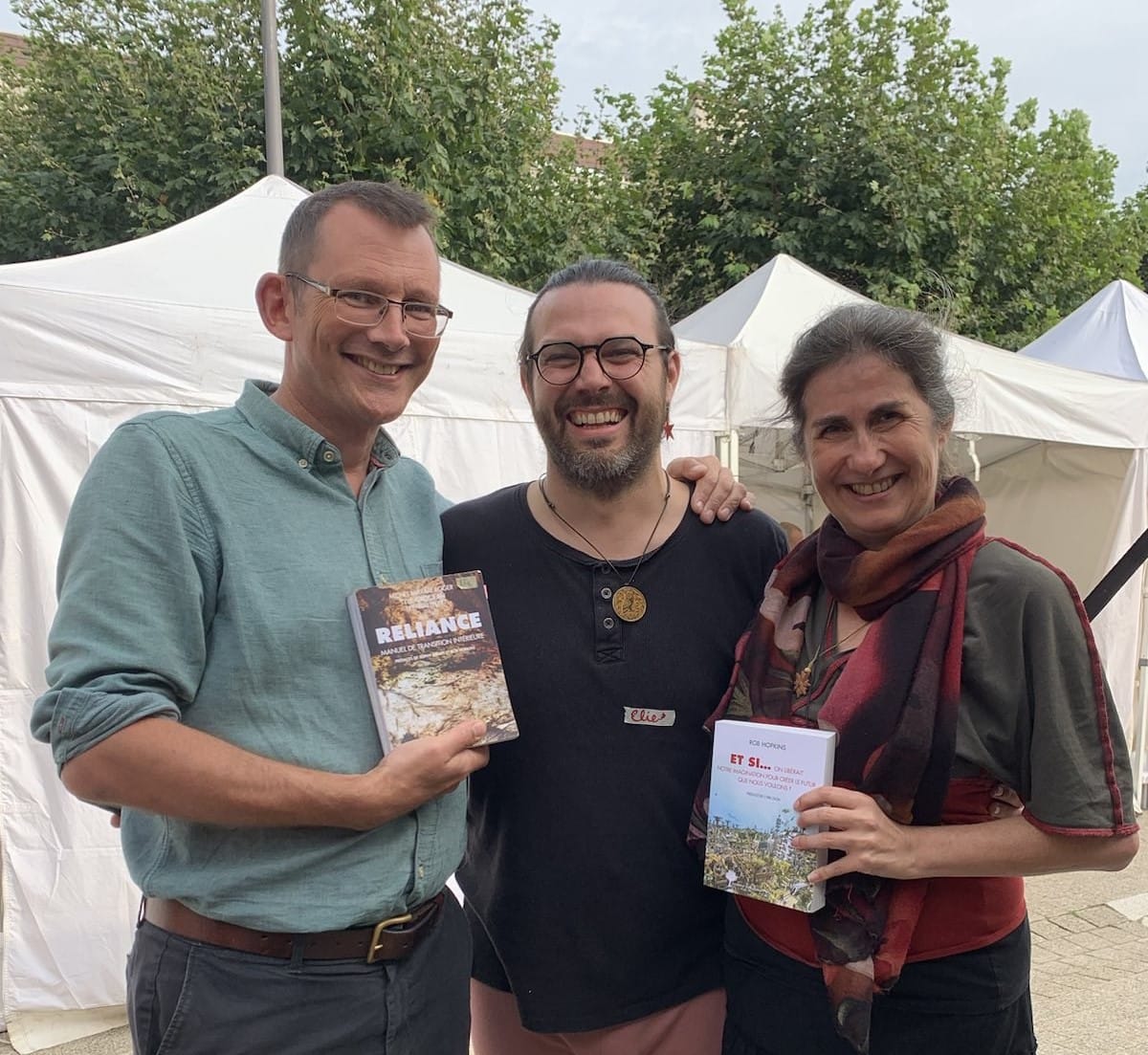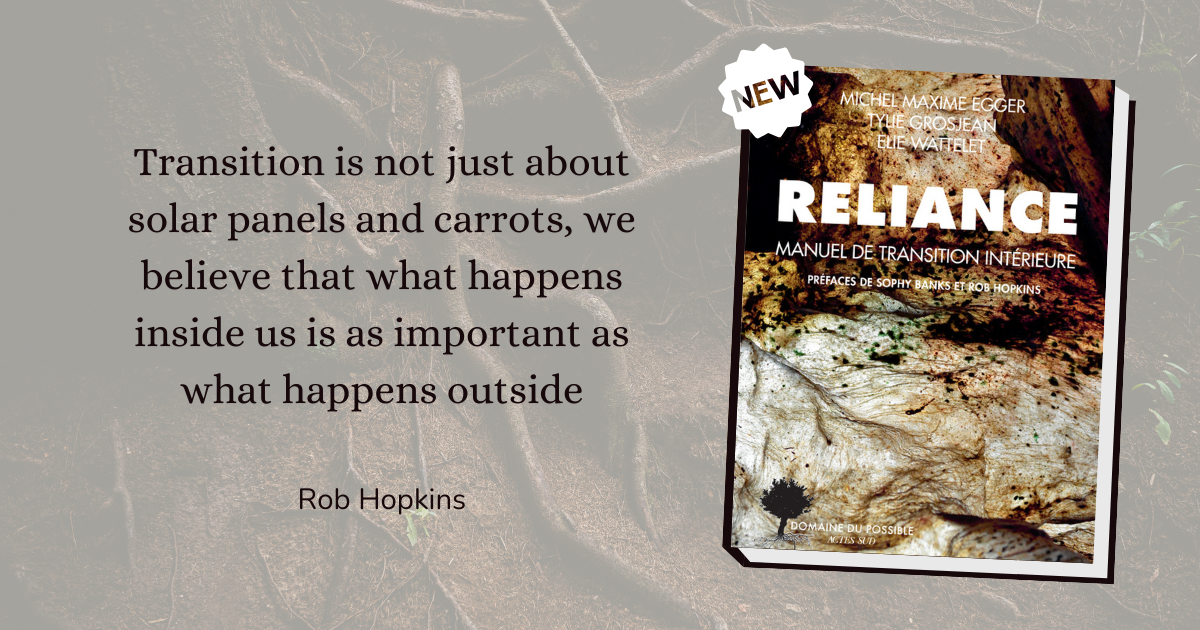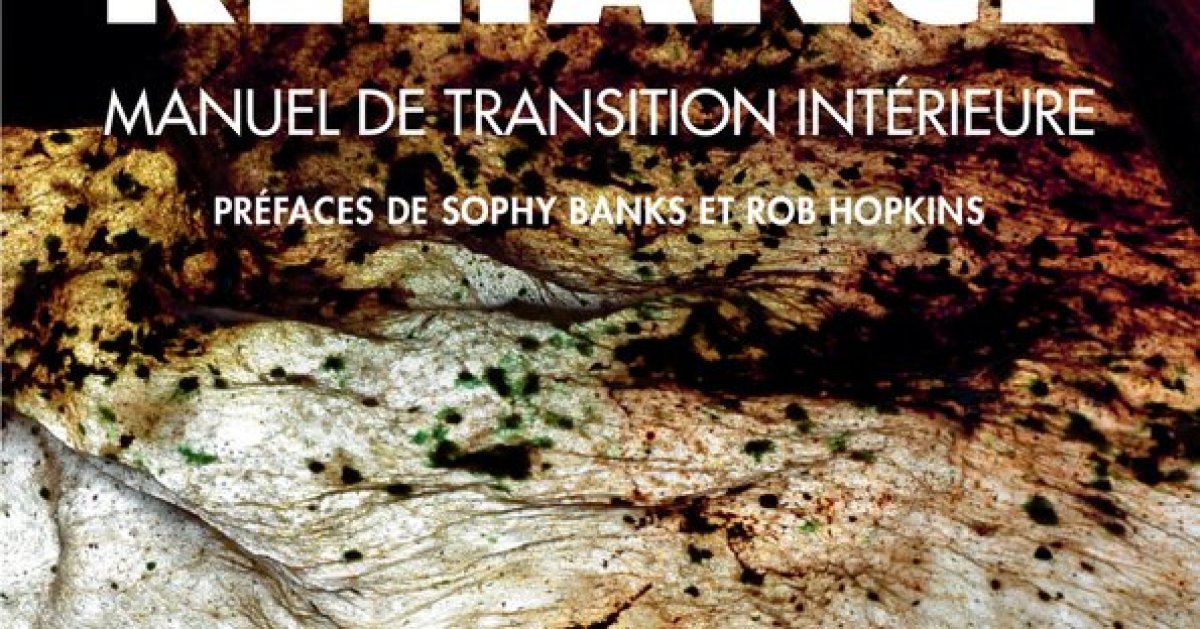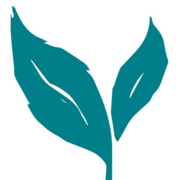Reliance, the new Inner book

Reliance, the new Inner Transition book, is now available in French! Rob Hopkins interviewed Tylie Grosjean and Elie Wattelet, two of the authors.
The book was also written by Michel Maxime Eggert, and it includes two prefaces, one by Sophy Banks and another one by Rob Hopkins.

It is these inner dimensions - cultural, psychological and spiritual - of transition that the 3 authors set out to explore. Their decades of experience within the Belgian and Swiss transition networks make their words invaluable. This book is destined to become a classic of its kind.
Actes Sud publishers

Hopefully we'll be able to share soon more news on an English version, fingers crossed! For now, please enjoy the interview:
Rob Hopkins interview to Tylie and Elie
Rob: The first question would be if you could both just introduce yourselves to anybody who doesn't know who you are. How would you introduce yourselves?
Tylie: I’m Tylie Grosjean, a mother of two children aged 24 and 21. I have a passion for human relations and ecology and I have had this passion for over 30 years. I have had the joy, the great fortune of working with quite a few eco advisors, providing them with training in human relations and efficient change management support. Over the decades, I have increasingly felt the need to try to understand in great depth why human beings don't change their ways of living in spite of living in a world which is quite objectively deteriorating.
I've increasingly felt the need to use my vital energy in projects that have to do with Inner Transition, and we've been working on this with Elie Wattelet in the context of the Belgian programme, which is now in its fourth edition, and I was also involved in co-writing a book on Inner Transition. Given the requirements that were voiced by the people who attended all our training programmes and we've been doing this and disseminating all this through the Transition Network in French-speaking Belgium.
Elie: I’m Elie. I immediately fell in love with whatever has to do with living beings. Initially by background I studied psychology, but I was very quickly involved in environmental associations. We started asking ourselves many questions as to how we should arouse broad awareness regarding all these issues. In parallel I started working on in areas such as collective intelligence and the theory of sustainable psychology in change management.
Somewhat later I had a daughter. She is now 14 and two or three years after she was born I came across Transition initiatives and there I discovered a movement where people realised how important it is to work with one's head, one's heart, and one’s hands at the same time. I found this a great source of inspiration, one I became very enthusiastic about.
I was involved in quite a few initiatives at community level as well, and in 2013 I suffered a burnout. This was at the time when there was the publication a report which stated that we were experiencing the 6th Mass Extinction. I was involved in Liege en Transition at the time, and in the Work That Reconnects.
We focused on the support of Transition initiatives. We created the Wallonie/Bruxelles Transition Network for French-speaking Belgium. In the area of ecopsychology, along with Tylie, we created training programmes in that field. I took part in the Inner Transition training programme with Sophy Banks in London in 2015 and after that we set up training programmes in Inner Transition.
I felt that I needed to challenge the shortcomings of our associations and networks. Therefore, I was involved in the creation of two more networks, one of them called Mycelium, which brings together various forms of ecological thinking: ecofeminism, popular ecology, and other forms as well. And another network, more specifically dedicated to the sensitive approaches of Transition and ecology. Now I'm especially busy with finalising completing the writing of the book and what happens after you release a book. I’m also involved in ecopsychology and the two networks I just mentioned.
I have a three-year old now too. We live in a shared housing unit by forest. We go to the woods with the family as often as we can and I joined a Forest School with seven families. We take the kids into the forest several days a week.
Rob: The book that you wrote is actually the first book about Inner Transition. You mentioned doing the training with Sophy but that she never wrote a book (although she is still continuing to develop her work on Healthy Human Culture). I wonder if you could give us an overview of what you say in the book, what is the key message of the book? Why did you write it? What does it include?
Elie: What Sophie taught us is that Transition is an all-encompassing approach. It involves working on initiatives, projects, working together as citizens and human beings, and it all also involves a cultural aspect as to how we should go about working together and how we have to factor in the human dimension with respect to life.
To bring about significant change, deep seated change, not small steps, we have to bring together the sociopolitical and psycho-spiritual dimensions. The question as to whether we should transform ourselves, given that the world is transforming, or whether the world is transforming because we are transforming, that question to us is pointless. It's irrelevant. It's a chicken and egg question, so there is no answer.
For us, the answer is that it's something that's circular and we have to get moving and it's a constant dance between those two approaches. As you said Sophy never wrote a book and lots of people asked us for a book. Then we came across Tylie and I came across Michel Maxime and his Inner Transition workshops. With his experience and the experience of Transition initiatives, we figured we had an all-encompassing landscape for Inner Transition, the perfect trio!
The landscape is not complete in the book. We don't think it ever will be, but we have tried to give an overview of the Inner Transition dimension that is involved in every Transition initiative. This journey starts with looking at the foundations. What foundations should we base our building a new society on? We have identified one as the power of imagination and stories, something that Rob is somewhat familiar with!
Another foundation is dualism, becoming aware of the fact that society’s traumas result from imbalances of power in terms of separation and domination along the lines of gender (masculine/ feminine), social class and along the lines of human beings versus nature at large. There are actually four: masculine/feminine, human versus nature, reason versus emotion (all this with the notion of separation and domination ) and the fourth is whether we have to consider that society has to become uniform or should it be a society of multiplicities and diversity. The third is the spiritual dimension. We're talking about secular, open, multifaceted spirituality and how Transition and spirituality feed each other.
Based on those foundations (that chapter of the book is called Metamorphosis), we have to consider how we have to navigate in the world as it currently stands with the stories that are told in terms of very negative stories, collapse, disasters and so on, and how we have to embrace our emotions in the face of all that and how we have to convey power to our emotions and how we have to run and design rituals to face up to that.
The stories are not negative. They're powerful and they have both positive and negative aspects. Another part of the chapter Metamorphosis has to do with how we overcome obstacles, impediments to integrating Inner Transition in our personal and collective lives.
We also have to consider obstacles in terms of the notion of ego, both individual and collective, and the issue of dependence, how society needs addictions like economic growth and consumerism, and how we have to embrace and face up to that.
And then we reach the third part of the book, which has to do with integration and what we do with all this in our lives. This has to do with what should be done in order to bring about a culture of care, a regenerative culture, both care to individuals and care in terms of cooperation and mutual support.
An important question is how all these Inner Transition notions can be beneficial not only to the upper and middle class which is white and educated, but to as many people as possible, regardless of background and origin, both now and moving forward.
We also explore how, at a personal level we can challenge our way of being, with respect to care and with respect to the spiritual dimension. We consider that the individual has both an aspect that has to do with meditation and with being militant. Sacred activism, as they say in the Anglo-Saxon world.
We have to consider all the tensions, all the paradoxes that are present, and we have to consider a number of qualities that are necessary to move forward and up - notions like courage, humility, gratitude, all these virtues that have to be nurtured and that are absolutely necessary to move ahead.
To close this section of the book which deals with theoretical questions, we close on this notion of dualism by saying that we have to stop this clear-cut dualism between interiority and exteriority. We also have to consider how our experience, how our journey and everything we've learned, how all that applies to the economic world, the educational world, medical world, cultural world, the political world, and how we can challenge what has to be improved in our collective approaches, and how diverse movements can be brought together in order to achieve greater strength.
That’s the first part of the book, which is theoretical, and is a little under one half of the book. The other larger half gives 24 practises to be applied either alone or collectively, and they are either short or long.
The final part of the book is in fact a compilation of various models that are widely used in Inner Transition, a kind of lexicon of emotions, of grief-related aspects, a whole list/compilation of references used in Inner Translation, and we give this for educational purposes. We wrote this book as though it were what we needed in terms of Inner Transition in Transition initiatives.
Rob: Tylie, one of the things that always was a big learning for me from Inner Transition was the importance and the power of good facilitation, that this is a revolution that will need good facilitators. In your experience, are good facilitators born or can they be trained? What are your thoughts on that?
Tylie: Yes, good facilitation already exists, as Elie suggested, in the Transition initiatives. Of course, there already is a sense of collective intelligence and shared governance, and this serves Inner Transition, it's a back-and-forth movement.
There are a number of skills that are absolutely necessary, like being able to closely pay attention to people expressing themselves. The notion of empathy is critical as well, and this, of course, is nurtured in circles that are involved in outer Transition and it can be found in the initiatives and practises and even more so of course in Inner Transition practises, so these skills and relations do often exist. People do have them, but they do not replace the need for training in these skills.
Another dimension has to do with the fact that there's often some confusion. Inner Transition is often mistaken for an individual journey, but in actual fact in Inner Transition, the facilitator recreates moments where individuals are on their own in the form of introspection, but they're not on their own because they have the support from the circle that they are involved in and the facilitator of course plays a critical role in this.
The facilitator sets up moments where there can be a form of introspection, of course. But work also has to be done in a sense of togetherness, in order to look at the ways in which it is possible to transform awareness, beliefs with the sense of domination that Elie explained when he spoke about the dualism aspect. We work in in pairs, in groups of three or in a full circle - when you facilitate, that's what you do. There's a dimension where care must be brought to one's self outside the circle as well.
There is complementarity between the work done by facilitators and psychological support, or therapeutic support even, to overcome the obstacles Elie mentioned, resulting from excessive egos. There is indeed a need to heal. Self-introspection is a compliment to the work that is done in circles with the facilitator and this, of course is connected to the social dimension, to society at large, but there is definitely a difference between self-help and Inner Transition and that has to be stated.
It has to do with what we call ‘engaged self-care’. The idea is not just to help people get back on their feet, you know, pull their socks up and do more of the same as they used to do before. No, that's not the point at all. We don't want people to dive back into consumerism and the brutal economy that we are experiencing on a daily basis.
Inner Transition in that respect is like a tightrope journey because we have to deal with our eco-emotions and it's sometimes difficult because when our awareness becomes very stark it can be brutal in fact. It's like a circular motion, we have to identify moments when we need self-therapy, other moments when we may need collective work and facilitation. Of course, in that regard, working in a collective way, both outer and inner. Inner Transition is by no means an exact science. You have to think on your feet and learn as you go along.
Rob: Elie, one of the things with the Transition movement is that as a movement, it has always tried to negotiate that tension or that balance between being and doing, which Sophy talked about a lot. Some movements get very focused on doing and then they neglect to pay attention to how they do things and to the inner side, and some movements maybe focus too much on the inner and don't manifest any real change in the world. How do you think, from your insights with this book, people can best find their place on that spectrum?
Elie: The book is designed to help people understand that both dimensions go hand in hand. Many of the practises point to how we have to rework our inner self in order to collectively work together. But we do stress the fact that with a sense of togetherness, we don't want each individual to be a shining example of a perfect balance, because that would recreate individualism. The idea is not to bring about a ‘new norm’ that everybody has to bend to and to comply with.
Rather the idea is how to strike a balance in a collective structure with a sense of togetherness and of course the balance that is reached depends on the individuals that make up the collective structure, and it can vary from one group to another of course, it's not this done in the same way. It's not the same balance.
We always have to keep an eye on the action we are aiming at. But of course, this does require considering our being, both individual and collective, and care, both individual and collective. But if we focus too much on care, self-care, individual care, introspection, maybe we'll be missing out on the things that need to be done in the world.
Caring for oneself and healing is a constant process. I mean, it's never ending. If you just wait to feel better in order to act then you'll just end up dying, period. And acting heals.
And this brings us back to what we were saying earlier about uniformity and multiplicity. This is not a new religion, not at all. We need multiple strategies because we don't really know what is going to work best. It's trial and error and there's no obvious truth out there immediately, so we have to consider multiple options and work with them. We also have to consider obstacles and problems like exhaustion or conflicts and so on. We have to embrace that and move along.
Rob: One last question for Tylie. How has the book been received since it was published? And what are your hopes and your dreams for what it will produce in the world?
Tylie: The reception has been very good in the community of people who are already on an Inner Transition journey. They were expecting this book as something complementary to The Transition Handbook. It disseminates among people given the lectures that we've been giving and the writings and the training programmes and so on, it has been disseminating, the practises have been. For instance, we were in Brittany with a group of 15 people and they have definitely rolled up their sleeves and found that they have a role to play in terms of disseminating the book and its content. In that regard, the dream is coming true in the Inner Transition circle, and people are becoming fortified in that regard. As regards the public at large, whose awareness remains small to date, well, we don't really know, although I'm getting more and more feedback from people who are telling me, hey, I've read the book or speed read it and it's very interesting, I will speak about it and so on. It's quite promising and encouraging in that regard.
Elie: I will just add that all the first copies have been sold, so it has to be reprinted and the publisher is quite happy. We have been offered to make a graphic novel from the book. That is going to take a lot of time and effort. Up until now, the mainstream press has not been very responsive. Therefore, they're not reaching the public at large.
Rob: Well, thank you both so much for your time and thank you for your beautiful gift to the world. I hope that when we make the article from this interview that it will increase interest again in in the book. So lovely to see you both again and thank you so much for your time.
Tylie and Elie: Thank you, thank you.
Tylie and Elie are members of the Reseau d'Ecologie Sensible. You can find out more about the project here:

Would you like to join the international Inner Transition Community? Click the button below:






